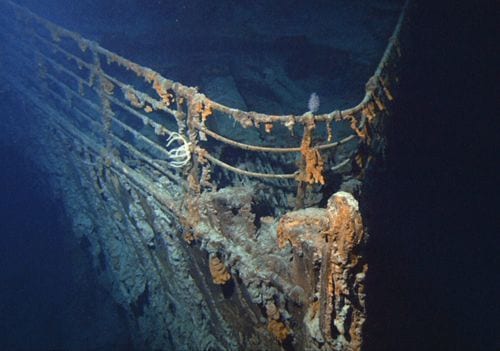Argo
Most people have heard of the Titanic, whether they’ve seen the movie or not. Ever since the ship sank, historians and researchers have worked to uncover exactly what happened when it hit the iceberg. Only a few have seen the wreck up close. In 1995, explorer Robert Ballard discovered the first remains of the Titanic southeast of Newfoundland using a deep-sea submersible called Argo.
A Propeller Found
Among the wreckage, Ballard’s team found one of the Titanic’s three massive propellers on the starboard side. The ship had two side propellers, each 23 feet wide, and a smaller middle propeller measuring 16 feet. A photo taken before the ship’s launch shows their enormous size. If the Titanic were upright, it would have been taller than the tallest buildings of that time.

First-Class Dining Room
On Deck D, the First-Class Dining Saloon was the largest room on the Titanic. It measured 114 feet long and could seat 500 passengers. The walls were finely decorated and painted white, with glass windows covering the portholes. Special lighting at night made the room feel like a high-end restaurant.

First-Class Smoking Room
Located at the back of the Promenade Deck, this space was for men to relax, smoke, and socialize. The walls were decorated in mahogany with pearl inlays. A famous painting, “The Approach to the New World” by Norman Wilkinson, hung above the fireplace. Guests could sit at tables, chat, or play cards.

Second-Class Accommodations
Seven decks on the Titanic were for second-class passengers. Their accommodations were as comfortable as first-class rooms on other ships. They had access to a library, smoking room, dining saloons, and Promenade Decks. The rooms featured oak paneling, carpeted floors, and wooden furniture, including a sofa, wardrobe, and dressing table.

The Grand Staircase
The ship’s interior mixed different architectural styles. The Grand Staircase was one of the most famous features. It was made of oak and designed in a neoclassical style, with wrought iron railings inspired by Louis XIV.

Lifeboat Shortage
The Titanic carried 2,208 passengers but had lifeboats for only 1,178 people. When the ship sank, 18 lifeboats were launched between 11:45 PM and 2:15 AM. Many were not filled to capacity. Some say the crew feared the boats would collapse under too much weight. Others say they followed the “women and children first” rule too strictly.

The Iceberg That Changed History
The Titanic struck an iceberg four days into its journey from Southampton to New York City. The ship took about two hours and 40 minutes to fully sink. Out of 2,224 people on board, more than 1,500 lost their lives, making it one of the deadliest maritime disasters in history. Today, the Titanic’s remains rest 12,500 feet below the ocean surface.

The Docks at Southampton
A photo shows crowds at the Southampton docks, waving goodbye as the Titanic set sail on April 10, 1912. First-class tickets cost as much as $100,000 in today’s money. Many passengers and their families had no idea it would be their last farewell.

The Captain’s Last Voyage
Titanic’s captain, Edward J. Smith, had been a British Merchant Navy officer for years. This was meant to be his final trip before retirement. There are different stories about his fate—some say he was last seen trying to save passengers, while others claim he went down with his ship.

